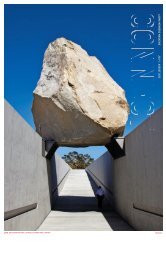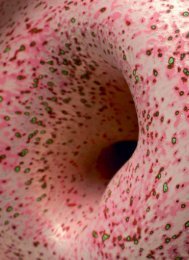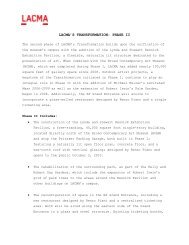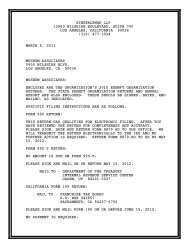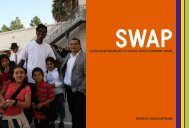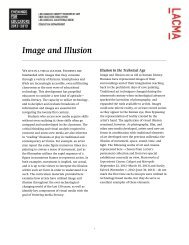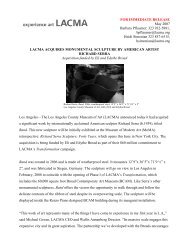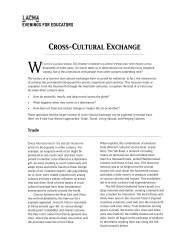Art of Many Cultures - Los Angeles County Museum of Art
Art of Many Cultures - Los Angeles County Museum of Art
Art of Many Cultures - Los Angeles County Museum of Art
You also want an ePaper? Increase the reach of your titles
YUMPU automatically turns print PDFs into web optimized ePapers that Google loves.
<strong>Art</strong> <strong>of</strong> <strong>Many</strong> <strong>Cultures</strong><br />
A Resource Guide For Teachers
Goals <strong>of</strong> this Resource Guide<br />
This guide provides information and suggested activities<br />
designed to help teachers prepare students to visit the<br />
<strong>Los</strong> <strong>Angeles</strong> <strong>County</strong> <strong>Museum</strong> <strong>of</strong> art, where they will<br />
participate in a docent-guided tour entitled <strong>Art</strong> <strong>of</strong> <strong>Many</strong><br />
<strong>Cultures</strong>. A second goal <strong>of</strong> the guide is to help teachers<br />
relate aspects <strong>of</strong> the tours to their schools curriculum.<br />
About the Tour<br />
This 90 minute tour is <strong>of</strong>fered for students in grades 6-12 and meets state<br />
content standards for history/ social science for grades 6, 7 and 10.<br />
The tour allows students to examine the visual characteristics <strong>of</strong> art from<br />
many places and cultures. While viewing such works students will gain an<br />
understanding and appreciation <strong>of</strong> many cultures, learning the role that art<br />
has played in ancient and modern cultures throughout the world and in<br />
religions such as Buddhism, Islam, Hinduism and Christianity. They will<br />
compare similarities and differences reflected in art, assess the<br />
characteristics that identify a work <strong>of</strong> art with its culture <strong>of</strong> origin, and<br />
learn how cultures influence each other.
About the<br />
<strong>Museum</strong><br />
LACMA is the largest<br />
encyclopedic museum in the western United<br />
States with more than 100,000 works <strong>of</strong> art.<br />
Through its far-reaching collections, the<br />
museum is both a resource to and a reflection<br />
<strong>of</strong> the many cultural communities and heritages<br />
in Southern California. The collection includes<br />
artworks from various cultures from the<br />
prehistoric to the present.
Suggested classroom activities<br />
before the museum visit<br />
• Distribute copies <strong>of</strong> the enclosed world map and have<br />
students locate the following locations:<br />
Egypt, India, Iran, Italy, and Mexico<br />
(These are just a few <strong>of</strong> the countries whose art may be<br />
featured on your tour.)<br />
• Discuss the elements <strong>of</strong> culture in each <strong>of</strong> the regions<br />
mentioned above. What languages are spoken? What<br />
foods might be eaten? What religions are practiced?<br />
How do students think these characteristics might<br />
manifest in the art they see at the museum?<br />
• Distribute copies <strong>of</strong> the glossary to the class and<br />
discuss the vocabulary.
Map <strong>of</strong> the World
Glossary<br />
Color<br />
The visual sensation dependent on the reflection or absorption <strong>of</strong> light from a given surface. Color<br />
is made up <strong>of</strong> hue, intensity, and value.<br />
Hue—refers to the name <strong>of</strong> the color (red, blue, yellow, orange)<br />
Intensity—refers to the brightness or dullness <strong>of</strong> a color<br />
Value— the lightness or darkness <strong>of</strong> a hue or neutral color<br />
Line<br />
One <strong>of</strong> the elements <strong>of</strong> art. Lines vary in length and direction.<br />
Lines can be horizontal, vertical or diagonal. They can describe structure or gesture, the outline <strong>of</strong> a<br />
shape or create patterns.<br />
Material<br />
<strong>Art</strong>ists use a variety <strong>of</strong> materials and tools to create art. Some materials are common and<br />
inexpensive (such as clay) while others are costly (gold and jewels). <strong>Art</strong>ists select their materials to<br />
support the intention <strong>of</strong> the work.<br />
Shape<br />
Geometric shapes such as circles, triangles, and rectangles, or freeform shapes, appear in many<br />
different kinds <strong>of</strong> art. They may form the underlying structure <strong>of</strong> the composition, or define certain<br />
parts. Shapes that are repeated establish patterns.<br />
Symbol<br />
Something that stands for or represents something else.<br />
Texture<br />
One <strong>of</strong> the elements <strong>of</strong> art. Texture is the way a surface feels or appears to feel. Texture can range<br />
from smooth and s<strong>of</strong>t to rough and hard.
The Hope Athena<br />
2nd century A.D.<br />
About the Image:<br />
Athena, the Greek goddess <strong>of</strong><br />
wisdom and war waged for just<br />
causes, wears a breastplate<br />
decorated with a head <strong>of</strong> a gorgon,<br />
the monsters whose piercing gaze<br />
turned to stone everyone whose eyes<br />
they met. The statue was excavated at<br />
Ostia, the port <strong>of</strong> Rome, in 1797. The<br />
hollow eye sockets suggest that the<br />
eyes originally were inlaid.<br />
This Athena is a Roman copy <strong>of</strong> a<br />
Greek original, the so-called Hope-<br />
Farnese type <strong>of</strong> Athena, named after<br />
LACMA’s statue, which was once<br />
owned by Thomas Hope, and the<br />
other fairly complete version in<br />
Naples, which came from the princely<br />
Farnese family.
Standing Warrior<br />
200 B.C. - A.D. 300<br />
Mexico, Jalisco,<br />
About the Image:<br />
This warrior figure, which may<br />
have served as a tomb guardian, is<br />
the largest known example <strong>of</strong><br />
funerary sculpture from West<br />
Mexico. Made in one piece, it is a<br />
masterpiece <strong>of</strong> firing. The figure<br />
wears a cap-like helmet with<br />
spikes; a stiff, leather vest; and<br />
short trousers. He raises a painted<br />
rod, possibly a club or baton<br />
signifying his rank. The redslipped<br />
brown clay and<br />
polychrome decoration, protruding<br />
stomach, and pellets <strong>of</strong> clay on the<br />
figure's shoulders, representing<br />
scarified tissue, characterize the El<br />
Arenal Brown type <strong>of</strong> West<br />
Mexican sculpture.
Shiva as the Lord <strong>of</strong> Dance<br />
c. 950-1000<br />
India, Tamil Nadu, South Asia<br />
About the Image:<br />
This sculpture depicts Shiva, the Hindu<br />
god <strong>of</strong> creation and destruction. Shiva is<br />
shown in action: he is poised on one<br />
foot, his leg raised across his body, and<br />
his arms extended. His hair flies out from<br />
his head as he dances. If you look<br />
closely, in his hair you will find a tiny<br />
mermaid-like figure; this is the river<br />
goddess Ganga. (She represents in<br />
human form the Ganges River, the most<br />
important river in India.) Shiva is<br />
surrounded by a circle <strong>of</strong> flames. In his<br />
upper right hand Shiva holds a drum,<br />
which represents the sound at the<br />
creation <strong>of</strong> the universe; the second right<br />
hand makes a gesture <strong>of</strong> reassurance.<br />
His upper left hand holds the flame <strong>of</strong><br />
destruction. The lower hand points to his<br />
left foot (believed to be the refuge <strong>of</strong> the<br />
soul), and to another important detail:<br />
with his right foot Shiva tramples the<br />
dwarf <strong>of</strong> ignorance.
Round-Topped Stela<br />
Mid-18th Dynasty,<br />
reign <strong>of</strong> Amenhotep III, circa 1391 - 1353 BCE<br />
About the Image:<br />
This stela, a flat slab <strong>of</strong> stone with a<br />
commemorative purpose, was created for<br />
Luef-Er-Bak, who is depicted by the<br />
figure on the right and identified by the<br />
hieroglyphs at the top. The stela was<br />
carved during the reign <strong>of</strong> King<br />
Amenhotep III in the middle <strong>of</strong> the<br />
Eighteenth Dynasty (1391-1353 B.C.E.).<br />
This stable and prosperous period is<br />
considered to represent the height <strong>of</strong><br />
ancient Egyptian artistic production. The<br />
stela was probably made for the<br />
necropolis (city <strong>of</strong> the dead) <strong>of</strong> Western<br />
Thebes, where it would have been placed<br />
in the tomb <strong>of</strong> the deceased.
Tile Section <strong>of</strong> a Mihrab<br />
Iran, Kashan, early 14 th Century<br />
About the Image:<br />
A mihrab is a characteristic<br />
architectural element in mosques,<br />
madrasas (theological colleges),<br />
and tombs throughout the Islamic<br />
world. It serves to emphasize the<br />
direction <strong>of</strong> Mecca (qibla), toward<br />
which Muslim prayer is oriented.<br />
Shaped like a niche, the mihrab is<br />
usually concave but flat examples<br />
also occur. This mihrab represents<br />
only the upper central panel <strong>of</strong> what<br />
was undoubtedly a larger ensemble.<br />
Its particular inscription, a passage<br />
from the Qur’an that refers to<br />
Paradise, suggests that it may have<br />
once graced a funerary monument.
Follow-up writing exercises<br />
After the museum visit<br />
Postcards<br />
Have younger students create postcards featuring their favorite work or art from the tour. On one<br />
side have them draw a picture <strong>of</strong> their chosen piece and on the reverse they can write a letter to a<br />
friend or family member describing the colors, shape, lines, textures and symbols <strong>of</strong> the object.<br />
Have students explain why they liked the work.<br />
Writing a Proposal for a <strong>Museum</strong> Exhibition<br />
Have older students collaborate to write a proposal for a museum exhibition that deals with some<br />
aspect <strong>of</strong> the <strong>Art</strong> <strong>of</strong> <strong>Many</strong> <strong>Cultures</strong> tour. In the proposal, the students should consider the<br />
following:<br />
• The theme <strong>of</strong> the exhibition. What will it be about?<br />
• The name <strong>of</strong> the exhibition<br />
• The reason the group thinks the exhibition will be enjoyable, educational and important to<br />
the public. (They are trying to persuade a museum director to support and fund the<br />
project.)<br />
• A list <strong>of</strong> objects to be included in the exhibition. Students can let their imaginations guide<br />
them. This could include photographs, posters, sculptures, paintings, clothing, movies<br />
and more.<br />
• Will there be a label for each <strong>of</strong> the objects or didactic (instructive) wall panels?<br />
• Will there be an exhibition brochure or related events?<br />
• Will there be an opening reception with invitations?
Additional Images and information about objects<br />
on your tour can be found by Visiting Collections<br />
Online at www.lacma.org<br />
• Ceremonial Ball Game<br />
Mexico, Nayarit,<br />
• Flower Day<br />
Diego Rivera<br />
• Mourners<br />
Mexico, Nayarit<br />
• Covered Double Spout and Bridge Vessel<br />
Peru, South Coast<br />
• Lamp<br />
Eastern Mediterranean<br />
• St. Michael Casting Satan into Hell<br />
Domenico Antonio Vacaro
LACMA General Information<br />
Please review these regulations with students before arriving at the museum.<br />
<strong>Museum</strong> Rules<br />
• No touching works <strong>of</strong> art including outdoor sculpture. Viewers must not come closer than 24 inches to any<br />
work <strong>of</strong> art.<br />
• No touching walls or any parts <strong>of</strong> installations. No sitting on platforms in the galleries or gardens.<br />
• No eating, drinking, smoking, gum-chewing, excess noise, or running in the galleries.<br />
• All groups must comply with instructions or requests from docents, gallery attendants or security staff.<br />
• Teachers and chaperones must stay with the students at all times and are responsible for student behavior.<br />
• Student assignments that require note taking are not permitted during a docent tour.<br />
Arriving at the <strong>Museum</strong><br />
• Plan to arrive at the museum at least 15 minutes before the tour is scheduled to begin.<br />
• The museum is located at 5905 Wilshire Boulevard where buses should arrive for students to disembark.<br />
• Enter the museum at the BP Grand Entrance on Wilshire Boulevard in front <strong>of</strong> Urban Light. A docent will meet<br />
your bus when it arrives.<br />
• Buses should park on 6th Street, which is one block north <strong>of</strong> Wilshire Boulevard.<br />
• Cars may park on surrounding streets or in the pay parking lot at 6th Street.<br />
Lunch<br />
• Picnicking is permitted at the tables outside the Ahmanson Building, the BP Grand Entrance or in the park,<br />
and students are welcome to bring sack lunches. Seating is not permitted in the Café or the surrounding patio.<br />
Box lunches may be purchased from the Café. Orders must be placed one week before your arrival. Please<br />
contact the Plaza Café (323) 857-6197.<br />
<strong>Museum</strong> Reentry<br />
• If you are planning to visit the galleries after your guided tour please present a copy <strong>of</strong> your confirmation letter<br />
at the Welcome Center on the BP Grand Entrance, or the <strong>Los</strong> <strong>Angeles</strong> Times Central Court, to receive free<br />
admission tickets. Your group may not enter the galleries until 12 noon when the museum opens to the public.
Enjoy your visit



